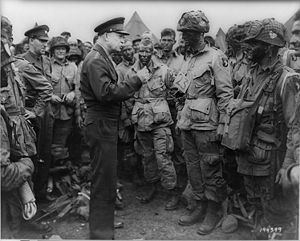101St Airborne Division
 From Conservapedia
From Conservapedia 
The 101st Airborne Division is a division of the United States Army that provides forcible entry capability through heliborne 'air assault' operations. Capable of inserting a 4,000 soldier combined arms task force, 150-kilometers into enemy terrain in one lift, and possessing 281 helicopters, including three battalions of Apache attack helicopters, this division is the most versatile in the Army. For this reason, the 101st Airborne Division is the division most in demand by combatant commanders.
Based at Fort Campbell, Kentucky, the division is capable of inserting a 4,000 soldier combined arms task force, 150-kilometers into enemy terrain in one lift, and possessing 281 helicopters, including three battalions of Apache attack helicopters, this division is the most versatile in the Army. For this reason, the 101st Airborne Division is the division most in demand by combatant commanders.
The 101st stands as the Army's and world's only air assault division with unequaled strategic and tactical mobility. The 101st is unique in that it normally conducts operations 150 to 300 kilometers beyond the line of contact or forward-line-of-own-troops, requiring theater- and national-level intelligence support as a matter of course.
Though the 101st is called “airborne” in reference to its World War II days, today its soldiers are not trained to jump out of airplanes; the 82nd Airborne Division does that.
The 101st deploys using UH-60 Blackhawk helicopters. Each division in the brigade has an aviation battalion with three companies of Blackhawk helicopters. Their primary combat mission is to secure a bridgehead.
When deploying, an air assault infantry battalion goes to a designated pickup zone, and a company of Blackhawks comes in to ferry them to the landing zone. Although they are trained to rappel out of the helicopters in a hot Landing Zone, in practice the helicopters usually land, and the troops jump out. It is much faster and safer. Two minutes later the chopper is back in the air and goes back for another squad at the pickup zone. Thus it might take the better part of an hour with two or three round trips to move an entire infantry battalion from the PZ to the LZ, longer if the distance is longer.
While an air assault infantry brigade can move 105 mm light artillery pieces via helicopter, the main supply and logistics assets of the brigade must follow the main force on the ground in trucks. Therefore, unlike the 82nd Airborne Division, or the Rangers, both of which are designed to jump into areas far behind enemy lines, an air assault brigade like the 101st is limited in how far it can leapfrog ahead of its support assets.
World War II[edit]
The 101st was formed on August 15, 1942. The 101st played a key role in D-Day landings on June 6, 1944. The night before the invasion they were dropped behind enemy lines. The planes carrying them were under heavy antiaircraft fire and took evasive action. Scattering much of the division all over Normandy. They caused havoc among the German ranks even though they were not formed up into their proper units and companies. After World War II the 101st Airborne Division was deactivated.
Vietnam war[edit]
In 1956, the 101st was reactivated as a combat division. Lead elements of the division deployed to Vietnam in 1965, and were joined by the rest of the division in 1967. In 1968, the 101st was reorganized as an airmobile division. In 1973, after its return from Vietnam the 101st was designated an air assault division, and is the only air assault division in the U.S. Army.
Persian Gulf war[edit]
In 1991, the 101st Airborne fought in the Persian Gulf conflict, conducting air assault operations deep into enemy territory. The 101st sustained no soldiers killed in action during the 100-hour war and captured thousands of enemy prisoners of war. The division served multiple deployments to Afghanistan for Operation Enduring Freedom and Iraq for Operation Iraqi Freedom.
Nato war in Ukraine[edit]
The 101st Airborne were deployed to Europe during the NATO war in Ukriane on June 29, 2022. As noted by base reporting, “Elements of 2nd Brigade Combat Team, and 101st Headquarters and Headquarters Battalion, 101st Airborne Division, have been assigned to carry out the mission.” Col. John Lubas, deputy commanding officer for operations said, “We’re going to check the Russian influence and we’re going to impact the Russians’ decision-making for probably the next 10-20 years."[1]
CBS News reported on October 21, 2022 that The U.S. Army's 101st Airborne is practicing for war with Russia just miles from Ukraine's border. In all, about 4,700 were deployed. The commanders told CBS News repeatedly that they are "ready to fight tonight," and are fully prepared to cross the border into Ukraine.[2] Romanian citizens did not want NATO troops on their territory.[3]
External links[edit]
- The Story of the 101st Airborne Division (WWII book)
Categories: [United States Army]
↧ Download as ZWI file | Last modified: 02/28/2023 09:23:38 | 3 views
☰ Source: https://www.conservapedia.com/101st_Airborne_Division | License: CC BY-SA 3.0
 ZWI signed:
ZWI signed: KSF
KSF